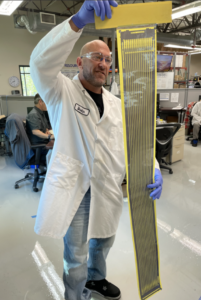Choosing Between Polyimide and LCP for Flex Printed Circuits: A Comparison
Choosing Between Polyimide and LCP for Flex Printed Circuits: A Comparison
In the world of flexible printed circuits (FPCs), selecting the right substrate material is crucial. Two popular materials, Polyimide (PI) and Liquid Crystal Polymer (LCP), dominate the market, each offering distinct advantages. However, in recent years, polyimide has gained prominence and is being increasingly favored over LCP in many applications. Let’s take a closer look at the pros and cons of these materials and why polyimide is emerging as a dominant choice.
Polyimide: Proven Durability and Versatility
Polyimide is a well-established material used extensively in flex circuit manufacturing. Its popularity stems from its exceptional thermal stability, mechanical strength, and electrical insulation properties. These characteristics make it highly suited for applications that demand reliability and endurance under challenging conditions.
Advantages of Polyimide:
- High Temperature Resistance: Polyimide can withstand extreme temperatures, often operating efficiently in environments ranging from -200°C to +300°C. This makes it ideal for aerospace, automotive, and industrial applications where temperature fluctuations are significant.
- Mechanical Flexibility: Its excellent flexibility allows polyimide-based FPCs to bend and flex repeatedly without damage, making it a strong choice for applications that require continuous movement, such as wearable electronics.
- Cost-Effectiveness: Polyimide is more cost-effective than LCP, both in terms of raw material price and ease of manufacturing. As a result, it offers a competitive solution for applications where budget is a consideration without sacrificing performance.
LCP: Specialized Performance in Select Applications
Liquid Crystal Polymer (LCP) has carved out a niche in specific high-performance applications. Known for its excellent moisture resistance and low dielectric constant, LCP is often chosen for applications that prioritize signal integrity and environmental resilience.
Advantages of LCP:
- Moisture Resistance: LCP’s hydrophobic nature makes it an excellent choice for applications exposed to high humidity or where moisture can cause performance degradation, such as in medical devices or underwater sensors.
- Low Dielectric Constant: LCP’s low dielectric constant ensures minimal signal loss, making it an attractive option for high-frequency applications, such as RF and microwave circuits.
- Thermal Stability: LCP also offers good thermal stability, although its temperature tolerance range is slightly lower than polyimide.
Disadvantages of LCP:
- Limited Flexibility: While LCP is flexible, it is not as robust as polyimide in applications that demand repeated bending or twisting. Over time, it may be prone to mechanical failure in such environments.
- Higher Cost: LCP is more expensive than polyimide, both in terms of raw material and manufacturing. This limits its use to high-end applications where the unique benefits justify the added cost.
Conclusion: Which Material is Right for You?
At MicroConnex, we have experience working with both polyimide and LCP flex circuit manufacturing. Our team is equipped to help you through the decision-making process, ensuring that you select the right material for your project. Whether you need the proven reliability of polyimide or the specialized performance of LCP, we’re here to help you make the best choice for your specific application.













